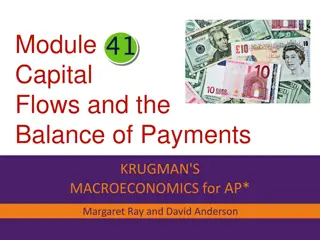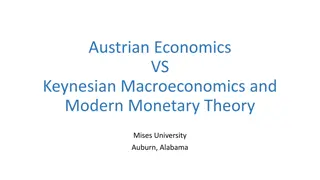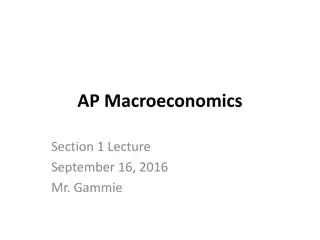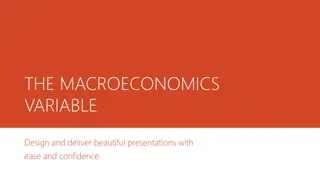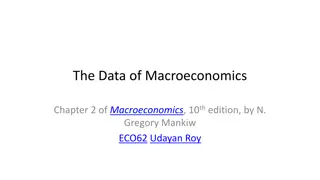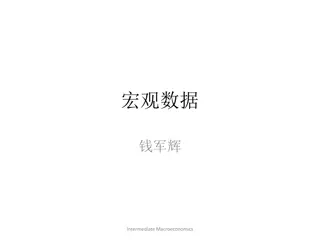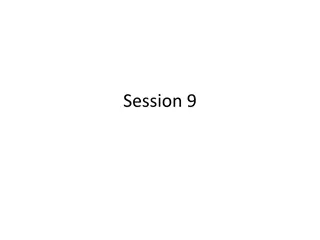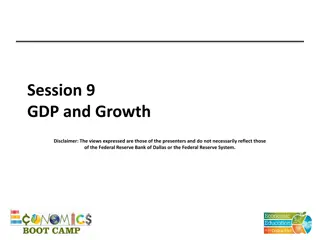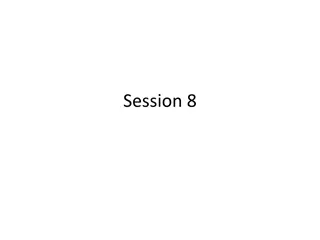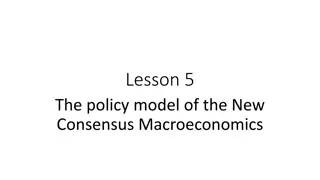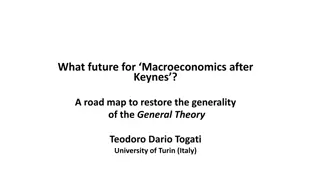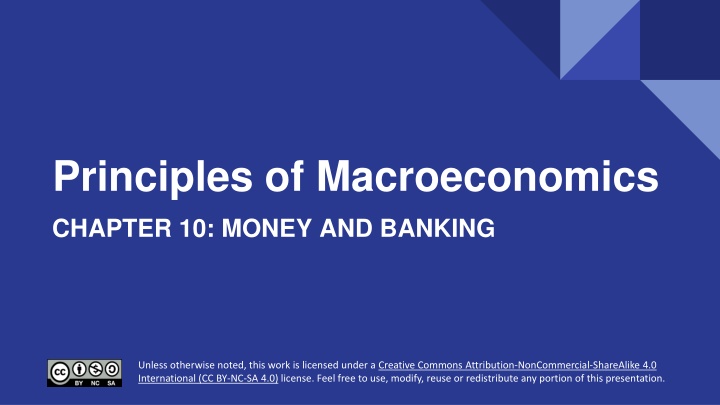
Understanding Money and Banking in Macroeconomics
Explore the fundamental concepts of money and banking in macroeconomics, including the functions of money, types of money, measuring money supply, and definitions of M1 and M2 in the context of Canada's banking sector. Enhance your knowledge of how money works in the economy.
Download Presentation

Please find below an Image/Link to download the presentation.
The content on the website is provided AS IS for your information and personal use only. It may not be sold, licensed, or shared on other websites without obtaining consent from the author. If you encounter any issues during the download, it is possible that the publisher has removed the file from their server.
You are allowed to download the files provided on this website for personal or commercial use, subject to the condition that they are used lawfully. All files are the property of their respective owners.
The content on the website is provided AS IS for your information and personal use only. It may not be sold, licensed, or shared on other websites without obtaining consent from the author.
E N D
Presentation Transcript
Principles of Macroeconomics CHAPTER 10: MONEY AND BANKING Creative Commons Attribution-NonCommercial-ShareAlike 4.0 International (CC BY-NC-SA 4.0) Creative Commons Attribution-NonCommercial-ShareAlike 4.0 International (CC BY-NC-SA 4.0) Unless otherwise noted, this work is licensed under a Creative Commons Attribution-NonCommercial-ShareAlike 4.0 International (CC BY-NC-SA 4.0) license. Feel free to use, modify, reuse or redistribute any portion of this presentation.
Learning Outcomes At the end of this chapter, you will be able to: Explain what money is and why we need it. Describe how money is measured in Canada today. Outline how banks create money. Identify the roles of the Bank of Canada and its open market operations. Explain the Equation of Exchange.
10.1 Functions of Money Economies without money use the barter system The barter system is inefficient because it requires a double coincidence of wants and does not easily allow for future contracts Money solves the double coincidence of wants as: It is accepted as a means of payment It stores value It serves as a unit of account
10.2 Commodity vs Fiat Money Commodity money means there is a value from use as something other than money Commodity-backed currencies are dollar bills or other currencies with values backed up by gold or another commodity held at a bank. Fiat money has no intrinsic value but is declared by a government to be the legal tender of a country.
10.3 Measuring Money The total quantity of money in the economy at any one time is called the money supply. Economists use broad definitions of money based on the concept of Liquidity. Liquidity is how quickly an asset can be used to buy a good or service. Liquidity is relative Credit cards are not money. It identifies you as a person who has a special arrangement with the card issuer in which the issuer will lend you money and transfer the proceeds to another party. You then repay the loan later.
10.3 M1 and M2 I There are 2 definitions of the supply of money M1: Assets that are the most liquid such as cash M2: M1 as well as some less liquid assets such as savings, time deposits, certificates of deposit, and money market funds.
10.3 M1 and M2 II In the table to the right are statistics for the banking sector in Canada (all numbers in billions of domestic currency). Coins and Currency 1400 Chequable Deposits 4 1200 Traveller s Cheques Savings Accounts 8000 Money Market Mutual Funds 400 Term Deposits 500 Using the data: M1 = 1400 + 4 + 1200 = $2,604 billion M2 = $2,604 + 8000 + 400 + 500 = $11,504 billion
10.3 M1 and M2 III Money Supply M2 in Canada increased to 2,384,951 CAD in November 2022 from 2,376,916 CAD in October of 2022. Money Supply M1 in Canada decreased to 1,557,237 CAD in November 2022 from 1,566,375 CAD in October of 2022
10.4 Banks and Financial Intermediaries An institution that amasses funds from one group and makes them available to another is called a financial intermediary. Examples include pension funds and insurance companies. Banks have a particularly important role as financial intermediaries. Depositors money is accepted and lent to borrowers Interest earns on loans allows banks to pay interest to depositors, cover operating costs, and earn a profit. Customers can open chequing accounts creating chequable deposits.
10.4 How Banks Create Money: 100% Reserve System 100% reserve banking system: simply storing money for depositors, not using deposits to make loans means that depositors cannot be paid interest.
10.4 How Banks Create Money: Fractional Reserve System I Refer to Fig 10.5, Singleton Bank keeps 10% of its total deposits with Bank of Canada, or $1 million, on reserve. This is called the reserve ratio. It will loan out the remaining $9 million. Loan is an asset because the bank earns interest from the loan. By loaning out the $9 million and charging interest, it will be able to make interest payments to depositors and earn interest income for Singleton. Money supply is $10 million in this example (remember deposits are counted as Money Supply).
10.4 How Banks Create Money: Fractional Reserve System II Singleton Bank lends $9 million to Hank s Auto Supply. Hank s Auto Supply obtains this loan and make purchases of auto parts from Ben s Company. Ben s Company has an account with First National Bank. When Hank pays the $9 million he lent from Singleton Bank to Ben s company, Ben deposits this money to the First National Bank. Every loan creates a deposit. Therefore, now money supply is $10million + $9million = $19 million.
10.4 The Money Multiplier The amount of money that a system can create is found using the money multiplier. This tells us how many times a loan will be multiplied through the process of lending out deposits The money multiplier formula is: ? ??????? ????? This is also called the simple deposit multiplier. In our example, the reserve ratio is 10%, so the money multiplier is 1/10% = 10. Therefore, money grows 10 times the original deposit. The original deposit in Singleton Bank was $10 million. So total money supply=10 $10million = $100million total money supply = 10 $10million = $100million.
10.5 Bank of Canada The Bank of Canada is led by the Governing Council. Its primary functions are: Act as a Banker to the Federal Government Act as a Banker to the private banks Issue bank notes and coins Act as a Lender of Last Resort Conduct Monetary Policy 1. 2. 3. 4. 5. Ottawa: Bank of Canada by Taxiarchos228, CC BY-SA 3.0
10.5 Overnight Interest Rate I The overnight interest rate setting is the Bank of Canada s key policy instrument in keeping the Canadian inflation rate within the target range of 1 - 3%. The Bank sets a target for the overnight rate at the midpoint of an operating band that is plus or minus one-quarter of one percentage point.
10.5 Open Market Operations I Central banks use open market operations, the purchases or sales of government securities in the open market, to manage the size of the money supply. There are two tools the Bank of Canada uses to maintain the overnight interest rate. 1) Special purchase and resale agreement (SPRA) The Bank offers to buy Government of Canada securities from financial institutions with an agreement to sell them back the next business day. The injection of cash increases money supply and puts a downward pressure on the overnight interest rate. Lowering the policy rate lower the prime lending rate and most interest rates prevailing in the markets fall.
10.5 Open Market Operations II 2) Sale and repurchase agreement (SRA) This is a sale of securities to financial institutions for one day combined with a repurchase the following day. There is a one-day reduction in money supply that puts upward pressure on the overnight rate raising the operating band. Raising the policy rate target raises the prime lending rate and most interest rates prevailing the markets rise.
10.6 Overnight Rate and its Implications on the Economy I If the Bank of Canada expects the economy is slowing down, they would lower the overnight interest rate target and conduct an open market operation of SPRA. The prevailing market interest rates are lowered, and the money supply is increased. The value of CAD decreases and consumption and investment increase as the borrowing cost lowers. The components of the aggregate demand function increase, the aggregate demands increases, and the price level is raised.
10.6 Overnight Rate and its Implications on the Economy II If the Bank of Canada expects the economy is experiencing rising prices or inflation, they would raise the overnight interest rate target and conduct an open market operation of SRA. The prevailing market interest rates are raised, and the money supply is decreased. The value of CAD appreciates and consumption and investment decrease as the borrowing cost rise. The components of the aggregate demand function decrease, the aggregate demands decreases, and the price level is lowered.
10.7 The Equation of Exchange I The money supply can be related to the aggregate economy by using the equation of exchange MV=Nominal GDP Recall from earlier that the GDP deflator equals nominal GDP divided by real GDP. GDP deflator is noted as P here. P = ??????? ??? ???? ??? Therefore, Nominal GDP = P Real GDP Letting Y equal real GDP, we can re-write the equation of exchange as, MV=PY
10.7 The Equation of Exchange - Example A hypothetical economy that consists of 50 people, each who has a car and $10 in cash with no other money. The money supply of this economy is $500. First Month M = $500 and V = 1 Real GDP is measured as # of car washes Y = 50 car washes and P = $10 Money supply has been spent twice V = 2 Total output is $1,000 100 car washes have been produced Money supply has been spent three times V = 3 $500 1 = $10 50 Second Month $500 2 = $10 100 Third Month $500 3 = $10 150 The equation of exchange always holds.
10.7 Money, Nominal GDP, and Price-Level Changes I The equation of exchange can be rewritten in terms of percentage rates of change % M + % V % P + % Y Assume that velocity is constant, then the above equation becomes, % M % P + % YP Rewriting this as, % P % M - % YP That is, The rate of inflation = the growth in money supply growth rate of real GDP
10.7 Money, Nominal GDP, and Price-Level Changes II The equation helps to make the following predictions: If money supply changes faster than the growth rate of GDP, the economy experiences inflation 1. If the growth rate of GDP changes faster than money supply, the economy experiences deflation 2. 3. When both money supply and GDP change in the same proportion, inflation remains unchanged. The quantity theory of money holds that in the long run the price level moves in proportion with changes in the money supply, at least for high-inflation countries.
10.8 Key Terms Liquidity M1 M2 Money market funds Money multiplier Money supply Overnight interest rate Prime rate Quantity theory of money Savings deposits Unit of account Asset Balance sheet Barter Certificates of deposit Commodity-backed currencies Commodity money Double coincidence of wants Fiat money Financial intermediary Liability



